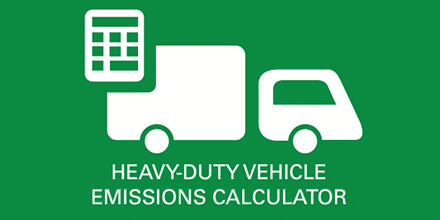On January 31, Argonne National Laboratory (Argonne or ANL) unveiled its new Heavy-Duty Vehicle Emissions Calculator (HDVEC) during a presentation at FedFleet 2018, the annual gathering of federal government fleet officials. The new ANL emissions calculator makes it easier for state officials and fleet operators to assess the emission reduction potential of various medium- and heavy-duty vehicle projects and to also evaluate the relative cost-effectiveness of reducing harmful emissions. The tool is expected to be particularly useful for persons evaluating or planning projects that could be funded by states using the Environmental Mitigation Funds set aside under the Volkswagen Settlement.
The new ANL emissions calculator makes it easier for state officials and fleet operators to assess the emission reduction potential of various medium- and heavy-duty vehicle projects.
The HDVEC was developed using Argonne’s Alternative Fuel Life-Cycle Environmental and Economic Transportation Tool (AFLEET). AFLEET Tool 2017 uses emissions data from both the U.S. Environmental Protection Agency’s Motor Vehicle Emission Simulator (MOVES) and Argonne’s Greenhouse gases, Regulated Emissions, and Energy use in Transportation (GREET) models. Unlike these other tools, however, HDVEC is a simple-to-use online calculator as opposed to a spreadsheet. In this way, it is a lot more like the Diesel Emission Quantifier (DEQ) tool developed by the U.S. EPA for the Diesel Emission Reduction Act (DERA) Program.
HDVEC provides fleets and policy makers with a tool that makes it easy to model environmental mitigation projects involving replacement and scrappage of older diesel vehicles with new vehicles or projects involving repowering an older diesel vehicle with a brand new, cleaner engine. Thus, it specifically allows for calculation of the types of projects called for under the Volkswagen Environmental Mitigation Trust. It also provides calculations for fleets that simply want to understand how various new vehicle options compare in terms of delivering emission reductions.
The emissions evaluated include vehicle operation nitrogen oxide (NOx) and fine particulate matter (PM2.5) emissions as well as the well-to-wheel greenhouse gas emissions (GHGs) of current commercially-available alternative fuel medium- and heavy-duty vehicles. Users can select from a variety of different types of vehicle projects and then must input project-specific information identifying the state where the vehicle will be operated in, the annual mileage, and years of operation. For scrappage projects, the remaining life of the vehicle to be replaced also must be entered.
The tool is expected to be particularly useful for persons evaluating or planning projects that could be funded by states using the Environmental Mitigation Funds set aside under the Volkswagen Settlement.
Like the AFLEET model, HDVEC also includes emissions factors for new, low-NOx engines and the latest estimated emission factors for in-use operation of diesel vehicles. Cost-effectiveness is based on the amount of funding requested and the amount of emission reduction generated by a specific project. Results are presented in an easy-to-review format with bar charts and the results can be saved or downloaded for future review.
We think the new vehicle emissions calculator will be very well received by state officials and organizations interested specifically in evaluating projects involving alternative fuel vehicles. There is a lot of interest now in these types of comparisons, particularly because of the $2.9 billion that is available from the Volkswagen Settlement and because of the general interest in sustainability and emissions reduction efforts. HDVEC also represents a significant improvement over the DEQ model which does not provide unique emission factors for alternative fuel vehicles, or allow users to quantify the benefit of using renewable fuels, both important features of HDVEC. That is why NGVAmerica has been encouraging state officials to use AFLEET to evaluate projects to fund using their Environmental Mitigation Funds and has pushed back against states that have said they intend only to use the DERA model. Using the DEQ model will show reductions but in the case of alternative fuels it won’t show differentiation with diesel vehicles even though most alternative fuel options are much cleaner than the newest diesel technology. NGVAmerica believes it is critical that states use tools that fully account for the benefits of alternative fuels. Because of the ANL unveiling of the HDVEC model, NGVAmerica plans to update its comments to urge states to also consider using this new emissions calculator.
HDVEC is available at: http://afleet-web.es.anl.gov/hdv-emissions-calculator/ and linked at NGVAmerica’s website at: http://www.ngvamerica.org/vwactioncenter/.


